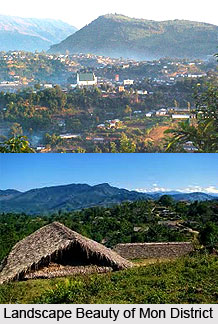Tourism in Mon District is the adventurous exploration of the various sites indulging in a number of beautiful sightseeing, trekking, fishing, and picnic spots to attract tourists. It provides serenity, peaceful environment undisturbed by the hub-hub of busy city life.
Some of the tourist spots are (a) Wanching, Wakching, Mon, Shangnyu, Chui, Longwa, Angphang, Monyakshu, Pessao and Changlangshu, famous for wood carving; (b) Sheanghachingnyu, Langmeang and Longwa are famous for skull exhibits and wood carving; (c) Dikhu river, Tizit, Tapi, Teyap etc. are sights for tourist attraction for fishing and picnicking; (d) Yetyong, Kaimang, Maksha and Thannyak rivers are popular for trout fishing; (e) Chiknyuho, Shawot, Ngupdang and Longwa are famous for Second World War remains and rock inscriptions; (f) Yei, Monyakshu, Pessao, Yongkao and Tamkong are the spots of attraction for ornithologists and for watching Tragopan birds; (g) Shangnyu and Chui have been declared as the ethnic villages providing a rich educational research work for anthropologists. These two villages are ruled by the Chief Anghs. Traditional architecture and old sculptures provide historical background of the past of Konyaks and their culture and tradition.
 The Konyaks are of Mongoloid in origin. Before the advent of Christianity into Nagaland, the Konyaks were the believers of "Animism" worshipping different objects of nature. About 95% of the population follows the Christian faith now. The Konyak society is obviously a patriarchal society and is dominated by male chauvinism. The eldest son of the family usually inherits the paternal property. The male members take all major decisions regarding the village; society etc. and women cannot partake in the discussion in the meeting. But trends are gradually changing with more liberal thinking and treating women as equal to men in all respects.
The Konyaks are of Mongoloid in origin. Before the advent of Christianity into Nagaland, the Konyaks were the believers of "Animism" worshipping different objects of nature. About 95% of the population follows the Christian faith now. The Konyak society is obviously a patriarchal society and is dominated by male chauvinism. The eldest son of the family usually inherits the paternal property. The male members take all major decisions regarding the village; society etc. and women cannot partake in the discussion in the meeting. But trends are gradually changing with more liberal thinking and treating women as equal to men in all respects.
The Konyaks speak different dialects in different villages. Each village has its own sub-dialect quite distinct from others. The Konyaks are hospitable in nature, warm hearted and fond of merry-making. Elderly men indulge themselves with "Khalap" which is black tea. A kettle is always left in the fireplace for boiling black tea.
Shanghyu village ruled by the Chief Angh is a prominent village in Mon district. There is a wonderful wooden monument measuring 8 feet in height and 12 feet in breadth is believed to be constructed by heavenly angels. Human beings and other creatures are carved on this monument. Memorial stones are also found in front of the Angh`s palace. History records that good and friendly relationship existed between the Shangnyu and the Ahom Kings of Assam. Shangnyu Angh used to collect taxes from all the villages under his domain-extending from Sibasagar in Assam to the Wanchos in Arunachal Pradesh.
Longwa Village is among the biggest village in the district. As the village straddles the international boundary line, one half of the Angh`s house falls within the Indian territory and the other half lies in Myanmar. However the whole village is controlled by the Angh and the Village Council Chairman. An interesting feature of this village is that the Angh of the village has 60 wives and his jurisdiction extends up to Myanman and Arunachal Pradesh.
Veda Peak is the highest peak in Mon district is approximately 70 kms east of Mon district headquarters. From this peak, one can have a clear view of both river Brahmaputra River and Chindwin on a clear day. There is a waterfall on the precincts of this peak and this area is also considered as one of the best locations in the whole of Konyak countryside.
Naganimora, formerly known as Lakhan, is a subdivision in Mon district and is situated in Kongan village land. The only coalfield in Nagaland, founded by British East India Company in 1907 is at Borjan near Naganimora. The second rail link to Nagaland from Simuluguri (Assam) also connects Naganimora. Every Saturday, there is an interesting weekly market here with a medley crowd of Assamese and Konyak Nagas.






